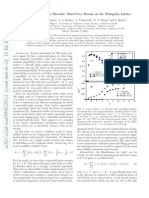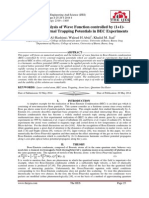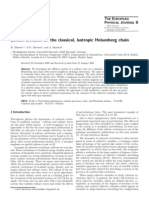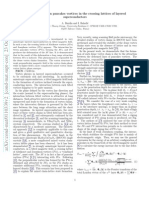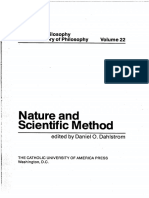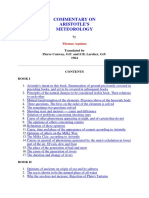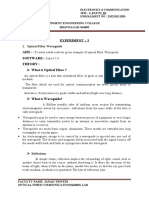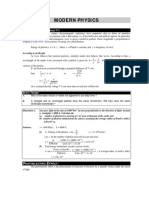Dynamical Superfluid-Insulator Transition in A Chain of Weakly Coupled Bose-Einstein Condensates
Dynamical Superfluid-Insulator Transition in A Chain of Weakly Coupled Bose-Einstein Condensates
Uploaded by
cdcrossroaderCopyright:
Available Formats
Dynamical Superfluid-Insulator Transition in A Chain of Weakly Coupled Bose-Einstein Condensates
Dynamical Superfluid-Insulator Transition in A Chain of Weakly Coupled Bose-Einstein Condensates
Uploaded by
cdcrossroaderOriginal Description:
Original Title
Copyright
Available Formats
Share this document
Did you find this document useful?
Is this content inappropriate?
Copyright:
Available Formats
Dynamical Superfluid-Insulator Transition in A Chain of Weakly Coupled Bose-Einstein Condensates
Dynamical Superfluid-Insulator Transition in A Chain of Weakly Coupled Bose-Einstein Condensates
Uploaded by
cdcrossroaderCopyright:
Available Formats
a
r
X
i
v
:
c
o
n
d
-
m
a
t
/
0
2
0
7
1
7
2
v
1
[
c
o
n
d
-
m
a
t
.
s
t
a
t
-
m
e
c
h
]
6
J
u
l
2
0
0
2
Dynamical Superuid-Insulator Transition
in a Chain of Weakly Coupled Bose-Einstein Condensates
A. Smerzi
1
, A. Trombettoni
1,2
, P.G. Kevrekidis
3
and A.R. Bishop
1
1
Theoretical Division and Center for Nonlinear Studies, Los Alamos National Laboratory, Los Alamos, NM 87545, USA
2
Istituto Nazionale di Fisica per la Materia and International School for Advanced Studies, via Beirut 2/4, I-34014, Trieste,
Italy
3
Department of Mathematics and Statistics, University of Massachusetts, Amherst, MA 01003-4515, USA
(February 6, 2008)
We predict a dynammical classical superuid-insulator transition (CSIT) in a Bose-Einstein con-
densate (BEC) trapped in an optical and a magnetic potential. In the tight-binding limit, this
system realizes an array of weakly-coupled condensates driven by an external harmonic eld. For
small displacements of the parabolic trap about the equilibrium position, the BEC center of mass
oscillates with the relative phases of neighbouring condensates locked at the same (oscillating) value.
For large displacements, the BEC remains localized on the side of the harmonic trap. This is caused
by a randomization of the relative phases, while the coherence of each individual condensate in the
array is preserved. The CSIT is attributed to a discrete modulational instability, occurring when
the BEC center of mass velocity is larger than a critical value, proportional to the tunneling rate
between adjacent sites.
PACS: 63.20.Pw, 05.45.-a
The recent experimental investigations of the dynam-
ical properties of a Bose-Einstein condensate trapped in
optical potentials [14], have led to a rapidly growing
interest in this topic [510]. The spatial and temporal
coherence of matter waves emitted at dierent heights
of the gravitational eld has been proven in [1], after
loading a condensate in a vertical optical trap. Num-
ber squeezed (non-classical) states have been realized in
[2]. In [3] Bloch oscillations and interband transitions in
an accelerating lattice have been observed. In [4], the
optical potential was superimposed on a harmonic mag-
netic trap, realizing a chain of weakly coupled conden-
sates (i.e., a Josephson junction array) driven by an ex-
ternal parabolic eld. For small initial displacements, the
condensate center of mass oscillated symmetrically with
the relative phases among adjacent sites locked togheter.
Here we demonstrate that for large displacements,
when the velocity of the center of mass reaches a crit-
ical value (proportional to the tunneling rate beteen ad-
jacent sites), the BEC abruptly stops on the side of the
harmonic trap (i.e., without reaching its center). We de-
ne an order parameter for the system, and show that
this dynamical transition from a superuid to an in-
sulator regime is associated with a randomization of
the relative phases among dierent wells. As we will
discuss below, this transition has a classical (mean-eld
or Gross-Pitaevskii) nature, and it is dierent (but with
some analogies) from the quantum superuid-insulator
(Mott) transition caused by the number squeezing of
the quantum states in each well [9]. It also diers from
the Landau dissipation mechanism, occurring in (quasi-
)homogeneous systems when the velocity of the conden-
sate is larger than the sound speed [6]. Rather, the CSIT
is driven by a modulational instability (MI) that causes
an exponential growth of small perturbations of a carrier
wave, as a result of the interplay between dispersion and
nonlinearity. The MI is a general feature of discrete as
well as continuum nonlinear wave equations. Its demon-
strations span a diverse set of disciplines ranging from
uid dynamics [11] (where it is usually referred to as the
Benjamin-Feir instability) and nonlinear optics [12] to
plasma physics [13]. One of the early contexts in which
its signicance was appreciated was the linear stability
analysis of deep water waves. It was only much later rec-
ognized that the conditions for MI would be signicantly
modied for discrete settings relevant to, for instance, the
local denaturation of DNA [14] or coupled arrays of opti-
cal waveguides [15]. In the latter case, the relevant model
is the discrete nonlinear Scr odinger equation (DNLS),
and its MI conditions were discussed in [16]. In this let-
ter we propose an experiment to observe a superuid-
insulator mean-eld dynamical transition (as a conse-
quence of the MI), with weakly coupled Bose-Einstein
condensates driven by an external harmonic eld.
The BEC dynamics is governed by the Gross-Pitaevskii
equation (GPE):
ih
t
=
h
2
2m
2
+ [V
ext
+ g
0
| |
2
] (1)
where g
0
=
4 h
2
a
m
, a is the s-wave scattering length, m
the atomic mass and the chemical potential. The con-
densate wave function (r, t) is normalized to the total
number of condensate atoms N
T
, and we consider a re-
pulsive interatomic interaction a > 0. The external po-
tential V
ext
is given by the sum of the harmonic conning
potential V
M
=
m
2
[
x
x
2
+
2
r
(y
2
+z
2
)] and the optical po-
tential V
L
= V
0
cos
2
(kx). The valleys of the potential are
1
separated by a lattice spacing of /2, with = 2/k.
We consider a chemical potential << V
0
and the trans-
verse degrees of freedom to be frozen by a tight magnetic
connement, so as to justify the study of the system in
an eective one-dimensional geometry.
In the tight-binding approximation (r, t) =
N
T
n
n
(t)
n
(r), with the wavefunction
j
of the
condensate in the j-th site of the array, weakly coupled
in the barrier region with the wavefunctions
j1
of the
condensates in the neighbour sites. It is then possible to
map the GPE onto the DNLS [7]:
ih
n
t
= K(
n1
+
n+1
) + (
n
+ U |
n
|
2
)
n
(2)
with K
dr
h
2
2m
(
n+1
) +
n
V
ext
n+1
pro-
portional to the microscopic tunneling rate between adja-
cent sites, U = g
0
N
T
dr
4
n
and
n
=
dr[
h
2
2m
(
n
)
2
+
V
ext
2
n
] = n
2
, with =
1
2
m
2
x
2
. The DNLS Hamil-
tonian is
H =
n
[K(
n
n+1
+
n+1
) +
n
|
n
|
2
+
U
2
|
n
|
4
]
(3)
with i
n
,
n
canonically conjugate variables. Both H
and the norm
n
|
n
|
2
= 1 are integrals of the motion.
Let us consider, rst, the case
n
= 0 (which corre-
sponds to neglecting the eect of the harmonic trap).
Stationary solutions of Eq. (2) are plane waves =
0
exp[i(knt)], of frequency = 2K cos(k)+U|
0
|
2
.
The stability analysis of such states can be carried out
by perturbing the carrier wave with small amplitude
phonons:
n
=
0
e
i(knt)
+ ue
i(qnt)
+ v
e
i(qn+t)
.
The DNLS excitation spectrum (for
n
= 0) is then given
by:
= 2K sin(k) sin(q)
2
4K
2
cos
2
(k) sin
4
(
q
2
) + 2KU|
0
|
2
cos(k) sin
2
(
q
2
). (4)
The carrier wave becomes modulationally unstable when
the eigenfrequency in Eq.(4) becomes imaginary:
U|
0
|
2
> 2K cos(k) sin
2
(q/2), (5)
namely, when cos(k) < 0. Therefore, if the interatomic
interaction is repulsive (U > 0), the system suers an
exponential growth of perturbations when /2 < k <
3/4. This result will remain valid in the case of non-
homogeneous travelling wave-packets driven by external
elds, when their width is much larger than the wave
length associated with the collective motion. This con-
clusion can be further understood in the light of the col-
lective coordinate equations of motion developed in [7].
Generally speaking, the mapping of the GPE into the
DNLS allows for the study of solitons and localized exci-
tations as well as dynamical instabilities in the framework
of the lattice theory [1719]. We remark, however, that
the MI is a general feature of the GPE with a periodic
external potential, and not necesserly in the tight bind-
ing limit. In the perturbative limit, >> V
0
, and in
absence of external driving elds (i.e., with V
M
= 0), the
MI has been studied in [6,8] (of course, in this limit the
MI condition doers from Eq.(5)).
The eect of the exponential growth of phonon modes
of arbitrary momenta in the DNLS leads to an eective
dephasing among dierent sites of the lattice. Indeed the
phases of each condensate enter into a running regime,
with an angular velocity dierent from site to site and
proportional to the local (on-site) eective chemical po-
tential. The complete delocalization in momentum space
leads to a strong localization in real space, hence to the
appearance of localized structures of large amplitude (see
Fig. 1). This localization has also been attributed (in the
absence of any external potential
n
= 0) to the presence
of the so-called Peierls-Nabarro barrier [20], which pins
such large amplitude solutions [21], not allowing them to
propagate. The excess kinetic energy is partially stored
to high-frequency internal ac oscillations among ad-
jacent wells (see also [22,23]), and partially converted
to wakes of small amplitude extended wave radiation
[20,25].
The CSIT can be observed experimentally by condens-
ing, rstly, the atomic gas in both the magnetic and the
optical trap, and, then, adiabatically displacing the mag-
netic eld from its initial position. For small displace-
ments, in line with the ndings of [4], the system coher-
ently oscillates about the center of the potential. If we
rewrite
j
=
n
j
e
ij
, this implies that the phase dier-
ence between sites is given by
j+1
(t)
j
(t) = (t).
The center of mass =
j
jn
j
and the phase dierence
will then satisfy
h
d
dt
(t) = 2K sin (t)
h
d
dt
(t) = 2 (t). (6)
Eqs. (6) have the usual form of the Josephson equa-
tions [24] and indicate that the overall array of bosonic
Josephson junctions behaves as a single Josephson junc-
tion, whose critical current is 2K/h. The collective co-
herence was experimentally demonstrated in [4] by the
interference pattern obtained upon releasing the conden-
sates from the optical and magnetic traps.
To monitor the dynamical transition of interest, we
dene < k >=
k
k|
k
|
2
= , with
k
the Fourier
transform of the condensate wave-function. In the co-
herent, small amplitude oscillations regime, the quasi-
momentum < k > exhibits regular oscillations (see Fig.
2). However, for < k > /2, the system becomes mod-
ulationally unstable and localization ensues. The critical
initial displacement
cr
can therefore be obtained from
Eqs. (6) with = /2. In lattice units:
2
cr
=
2K
. (7)
In Fig. 2 we plot < k > vs. time for three initial displace-
ments. When (t = 0) is smaller than
cr
, the average
momentum < k > oscillates in accordance with Eq. (6).
Note that for (t = 80) the system approaches very close
to the instability line. When the initial displacement is
larger than the critical value, < k > abruptly drops as
soon as it crosses the critical point. This is accompa-
nied by the sudden arresting of the BEC center of mass
(cf. Fig. 1) and by a collective dephasing (cf. Fig. 3).
The key experimental signature would be the disappear-
ance of the interference fringes after the expansion of the
BEC, while the center of mass of the resulting cloud will
be resting on the side of the traps center.
The values of the parameters in DNLS are V
0
= 5E
R
with = 795 nm and the recoil energy E
R
=
h
2
2m
2
,
N
T
= 50000, K = 5.5 10
2
E
R
and = 1.5 10
5
E
R
:
the critical displacement from Eq. (7) is
cr
84 sites,
in good agreement with our numerical ndings (cf. Figs
2 and 3). The loss of coherence is highlighted in Fig.
3, where we plot the temporal evolution of the modulus
squared of an eective complex order parameter measur-
ing the overall coherence of the system, dened as:
=
j+1
. (8)
When the collective oscillations are coherent, the value
of the order parameter is |(t)|
2
= 1 (see the cases
(t = 0) = 40, 80 in Fig. 3). On the other hand,
a complete dephasing is characterized by |(t)|
2
= 0,
and occurs for (t = 0)
cr
, or, equivalently, when
< k > /2 (cf. Fig. 2). It is worth noting that such
randomization takes place between the phases of conden-
sates localized in dierent wells, even though each one
remains internally coherent. This is shown in Fig. 1,
where we plot the density for dierent times below (a,b)
and above (c,d) the critical displacement. The numer-
ical solutions of the DNLSE and the GPE are in good
agreement. The motion of the center of mass in the su-
percritical case is reported in Fig. 4, where the numer-
ical solutions of the DNLS and the full one-dimensional
GPE (1) are compared. In both cases the system stops
at < x > 35 m (with a slight dierence between the
DNLS and the GPE predictions), while the center of the
harmonic trap is located at x = 0 m. From Eqs. (6)
we can calculate the critical current, i.e., the maximum
allowed velocity in the coherent transmission of matter
waves: by setting = /2 we readily see that the crit-
ical velocity of the center of mass,
max
is equal to the
critical current per particle I
c
= 2K/h. In dimensional
units:
v
c
=
K
h
(9)
which gives v
c
= 0.98 m/ms, in agreement with the
DNLS numerical result, and close to the numerical GPE
value v
c
= 1.18 m/ms.
From the above ndings, we can conclude that the ef-
fect of the MI is to dephase the system. In the eec-
tive 1D geometry we have considered, such dephasing is
strong enough to stop the falling condensate. In higher
dimensions, the dephasing can be partial, and will only
damp the BEC motion. Yet, its onset will still be given
by Eq. (9). The CSIT regards a classical eld (the solu-
tion of the GPE) and it is qualitatively dierent from the
quantum Mott insulator-superuid transition in meso-
scopic Josephson junction chains, which is driven by the
competition between zero-point quantum phase uctua-
tions and the Josephson coupling energy. Yet, it is pos-
sible to draw an analogy. In the former CSIT case, the
insulator regime is associated with a vanishing temporal
correlation among the phases of each site, each phase still
being meaningful in the GPE sense. The quantum transi-
tion is also driven by a loss of phase correlations induced
by the localization of atoms in each site, which, however,
arises from the non-commuting nature of the number-
phase observables. Clearly, such quantum uctuations
cannot be captured within the GPE framework. Also,
the latter transition is reversible (i.e., long-range phase
coherence is restored upon adiabatically increase of the
tunnel coupling), while the former is not. It is worth
noting that very recent experimental works [26] have il-
lustrated the existence (and reversibility) of the quantum
phase transition, rendering the experimental verication
of the classical dynamic transition suggested herein, a
natural next step for experimental studies. In conclu-
sion, we notice that the MI can be studied in term of one
(or several) bifurcation points in an eective stationary
Hamiltonian. Such bifurcation points separate regions
with dierent symmetries, and it is common in the liter-
ature to study such dynamical transitions in terms of an
order parameter [27], borrowing the language and con-
cepts of statistical phase transitions. This mapping, in
the specic case of MI, deserves further studies.
The modulational instability (and the consequent
superuid-insulator transition) studied here can also be
observed with dierent experimental setups (e.g., with
the condensate at the center of the harmonic trap and
with the laser moving across). In fact, similar MI and
pinning results have been obtained in the case in which
the harmonic trap is displaced at a constant speed ex-
ceeding a critical value [28]. These results illustrate the
generality and importance of the eects of the MI mech-
anism in the motion of Bose-Einstein condensates and
underscore its potential in inducing localization and de-
phasing of such coherent structures.
[1] B.P. Anderson and M.A. Kasevich, Science 282, 1686
3
(1998).
[2] C. Orzel, A. K. Tuchman, M. L. Fenselau, M. Yasuda,
M. A. Kasevich, Science 291, 2386 (2001).
[3] O. Morsch, J.H. M uller, M. Cristiani, D. Ciampini and
E. Arimondo, Phys. Rev. Lett. 87, 140402 (2001)
[4] F.S. Cataliotti, S. Burger, C. Fort, P. Maddaloni, F. Mi-
nardi, A. Trombettoni, A. Smerzi and M. Inguscio, Sci-
ence 293, 843 (2001).
[5] M.L. Chiofalo and M.P. Tosi, Phys. Lett. A 268, 406
(2000).
[6] B. Wu and Q. Niu, Phys. Rev. A 64, 061603(R) (2001).
[7] A. Trombettoni and A. Smerzi, Phys. Rev. Lett. 86,
2353, (2001).
[8] V.V. Konotop and M. Salerno, cond-mat/0106228.
[9] D. Jaksch et al., Phys. Rev. Lett. 81, 3108 (1998)
[10] P. Pedri et al., Phys. Rev. Lett. 87, 220401 (2001)
[11] T.B. Benjamin and J.E. Feir, J. Fluid. Mech. 27, 417
(1967).
[12] L.A. Ostrovskii, Sov. Phys. JETP 24, 797 (1969).
[13] T. Taniuti and H. Washimi, Phys. Rev. Lett. 21, 209
(1968); A. Hasegawa, Phys. Rev. Lett. 24, 1165 (1970).
[14] M. Peyrard, T. Dauxois, H. Hoyet and C.R. Willis, Phys-
ica 68D, 104 (1993).
[15] R. Morandotti, U. Peschel, J.S. Aitchison, H.S. Eisenberg
and Y. Silberberg, Phys. Rev. Lett. 83, 2726 (1999).
[16] Yu.S. Kivshar and M. Peyrard, Phys. Rev. A 46, 3198
(1992).
[17] A.C. Scott, Nonlinear Science: Emergence and Dynam-
ics of Coherent Structures, Oxford Univ. Press, Oxford,
1999
[18] D. Hennig and G.P. Tsironis, Phys. Rep. 307, 333 (1999).
[19] P.G. Kevrekidis, K.. Rasmussen and A.R. Bishop, Intn.
J. Mod. Phys. B 15, 2833 (2001).
[20] M. Peyrard and M. Kruskal, Physica 14D, 88 (1984).
[21] T. Dauxois and M. Peyrard, Phys. Rev. Lett. 70, 3935
(1993).
[22] Yu.S. Kivshar, D.E. Pelinovsky, T. Cretegny and M.
Peyrard, Phys. Rev. Lett. 80, 5032 (1998).
[23] P.G. Kevrekidis and C.K.R.T. Jones, Phys. Rev. E 61,
3114 (2000).
[24] A. Barone and G. Paterno, Physics and Applications of
the Josephson Effect (Wiley, New York, 1982).
[25] P.G. Kevrekidis and M.I. Weinstein, Physica 142D, 113
(2000).
[26] M. Greiner et al., Nature 415, 39 (2002)
[27] H. Haken, Synergetics, Springer-Verlag Berlin (1977);
G. Venkataraman and V. Balakrisnan, Sinergetica ed
Instabilita dinamiche, Course IC, Proceedings of the
International School of Physics Enrico Fermi, Varenna,
Caglioti, Haken and Lugiato Ed.s, (1988), 175
[28] A. Smerzi, A. Trombettoni, P.G. Kevrekidis and A.R.
Bishop (unpublished).
20 0 20 40 60
x (m)
0.0
0.2
|
|
2
0.00
0.04
0.08
|
n
|
2
20 0 20 40 60
x (m)
0.0
0.2
|
|
2
0.00
0.04
0.08
|
n
|
2 (a) (c)
(b) (d)
FIG. 1. The density calculated at dierent times 0, 20,
40 ms (from the right of each gure to the left) as a func-
tion of the position, with initial displacements
(
0) = 50, 120
sites, which are, respectively, below and above the critical
value xicr 84 (7). The GPE (b,d), and the DNLS (a,c)
wavefunctions normalized to 1 are compared. (a,b)
(
0) = 50
sites; (c,d)
(
0) = 120 sites. The external parabolic potential,
which drives the oscillations, is centered at x = 0.
0 100 200
time (ms)
2
1
0
1
2
<
k
>
/2
40
80
90
FIG. 2. The quasi-momentum < k > vs. time for three
dierent initial displacements: 40, 80 and 90 sites. When
< k > reaches /2 (i.e., for an initial displacement greater
than cr 84 calculated with Eq.(7) the system becomes
modulationally unstable.
4
0 100 200
time (ms)
0.0
0.5
1.0
|
|
2
90
40
80
FIG. 3. The modulus square of the order parameter
dened in Eq. (8) as a function of time, for three dierent
initial displacements (40, 80 and 90 sites) and with the same
parameters as in Fig. 2. When the quasi-momentum < k >
reaches /2 (i.e., for an initial displacement greater than cr),
the order parameter drops to 0; cf. Fig. 2.
0 100 200
time (ms)
20
30
40
50
60
<
x
>
(
m
)
FIG. 4. The center of mass vs. time for a supercritical
initial displacement of 150 sites. Solid line: Gross-Pitaevskii
equation; dashed line: discrete nonlinear Schrodinger equa-
tion. The (displaced) center of the trap is at x = 0 m.
5
You might also like
- K. Nakamura Et Al - Levitation of Spinor Bose-Einstein Condensates: Macroscopic Manifestation of The Franck-Condon EffectDocument8 pagesK. Nakamura Et Al - Levitation of Spinor Bose-Einstein Condensates: Macroscopic Manifestation of The Franck-Condon EffectPomac232No ratings yet
- Kinetics of Martensitic Phase Transitions: Lattice ModelDocument21 pagesKinetics of Martensitic Phase Transitions: Lattice ModelEdgar Apaza HuallpaNo ratings yet
- Semiconductor Nano RingsSemiconductorNanoringsDocument8 pagesSemiconductor Nano RingsSemiconductorNanoringsZsolt SzakácsNo ratings yet
- Explosion of Soliton in A Magnetic Field: 128.114.34.22 On: Sun, 30 Nov 2014 00:16:13Document4 pagesExplosion of Soliton in A Magnetic Field: 128.114.34.22 On: Sun, 30 Nov 2014 00:16:13mengforestNo ratings yet
- Ming-Shien Chang Et Al - Coherent Spinor Dynamics in A Spin-1 Bose CondensateDocument6 pagesMing-Shien Chang Et Al - Coherent Spinor Dynamics in A Spin-1 Bose CondensatePomac232No ratings yet
- R. G. Melko Et Al - Supersolid Order From Disorder: Hard-Core Bosons On The Triangular LatticeDocument4 pagesR. G. Melko Et Al - Supersolid Order From Disorder: Hard-Core Bosons On The Triangular LatticeMremefNo ratings yet
- Numerical Analysis of Wave Function Controlled by (1+1) - Dimensions External Trapping Potentials in BEC ExperimentsDocument5 pagesNumerical Analysis of Wave Function Controlled by (1+1) - Dimensions External Trapping Potentials in BEC ExperimentstheijesNo ratings yet
- PhysRevLett.101.130401Document4 pagesPhysRevLett.101.130401Shakir KhattakNo ratings yet
- Yu.V. Tolstykh Et Al - Relativistic Unsteady Petschek-Type Model of Magnetic ReconnectionDocument5 pagesYu.V. Tolstykh Et Al - Relativistic Unsteady Petschek-Type Model of Magnetic ReconnectionOkklosNo ratings yet
- Isotropic Scale-Invariant Dissipation of Solar Wind TurbulenceDocument5 pagesIsotropic Scale-Invariant Dissipation of Solar Wind TurbulenceKhurom KiyaniNo ratings yet
- IJMPA2013Document17 pagesIJMPA2013Gabriel MenezesNo ratings yet
- 2-Array of Bose-Einstein Condensates Under Time-Periodic Feshbach-Resonance ManagementDocument8 pages2-Array of Bose-Einstein Condensates Under Time-Periodic Feshbach-Resonance ManagementIsrael PeñaNo ratings yet
- PhysRevD 107 096019Document10 pagesPhysRevD 107 096019vinicius.fulconiNo ratings yet
- Quantum Phase Transition From A Super Uid To A Mott Insulator in A Gas of Ultracold AtomsDocument6 pagesQuantum Phase Transition From A Super Uid To A Mott Insulator in A Gas of Ultracold AtomsAsai BaraNo ratings yet
- PhysRevE 95 042204Document5 pagesPhysRevE 95 042204Défi JubgangNo ratings yet
- S.J.J.M.F. Kokkelmans Et Al - Resonance Superfluidity: Renormalization of Resonance Scattering TheoryDocument15 pagesS.J.J.M.F. Kokkelmans Et Al - Resonance Superfluidity: Renormalization of Resonance Scattering TheoryLomewcxNo ratings yet
- Stable Charged-Particle Acceleration and Focusing in A Laser Accelerator Using Spatial HarmonicsDocument5 pagesStable Charged-Particle Acceleration and Focusing in A Laser Accelerator Using Spatial HarmonicsParticle Beam Physics LabNo ratings yet
- The Supertranslation Memory Field (Vacuum Is Degenerate and Preserves Otherwise Lost Black Hole Information)Document9 pagesThe Supertranslation Memory Field (Vacuum Is Degenerate and Preserves Otherwise Lost Black Hole Information)Russell ClarkNo ratings yet
- Observation of Laser-Induced Field-Free Permanent Planar Alignment of MoleculesDocument6 pagesObservation of Laser-Induced Field-Free Permanent Planar Alignment of MoleculeszikramusaddiqaNo ratings yet
- L.O. Baksmaty Et Al - Tkachenko Waves in Rapidly Rotating Bose-Einstein CondensatesDocument4 pagesL.O. Baksmaty Et Al - Tkachenko Waves in Rapidly Rotating Bose-Einstein CondensatesPomac232No ratings yet
- Dependence of Nuclear Binding On Hadronic Mass Variation: PACS Numbers: 98.80.Cq, 26.35.+c, 21.45.+vDocument28 pagesDependence of Nuclear Binding On Hadronic Mass Variation: PACS Numbers: 98.80.Cq, 26.35.+c, 21.45.+vBayer MitrovicNo ratings yet
- Sergey K. Nemirovskii and Makoto Tsubota - Trial Distribution Functional of Vortex Tangle in Superfluid HeliumDocument2 pagesSergey K. Nemirovskii and Makoto Tsubota - Trial Distribution Functional of Vortex Tangle in Superfluid HeliumJuaxmawNo ratings yet
- Oller 1999Document22 pagesOller 1999Mario SánchezNo ratings yet
- Quantum Plasma Effects in The Classical Regime: PACS Numbers: 52.27.-h, 52.27.Gr, 67.57.LmDocument10 pagesQuantum Plasma Effects in The Classical Regime: PACS Numbers: 52.27.-h, 52.27.Gr, 67.57.LmMubashar IqbalNo ratings yet
- 1 s2.0 S0749603607002303 MainDocument4 pages1 s2.0 S0749603607002303 Maintsaqif putraNo ratings yet
- S. Wuster, T.E. Argue and C.M. Savage - Numerical Study of The Stability of Skyrmions in Bose-Einstein CondensatesDocument8 pagesS. Wuster, T.E. Argue and C.M. Savage - Numerical Study of The Stability of Skyrmions in Bose-Einstein CondensatesPomac232No ratings yet
- T. Tatsuno, V. I. Berezhiani and S.M. Mahajan - Vortex Solitons - Mass, Energy and Angular Momentum Bunching in Relativistic Electron-Positron PlasmasDocument20 pagesT. Tatsuno, V. I. Berezhiani and S.M. Mahajan - Vortex Solitons - Mass, Energy and Angular Momentum Bunching in Relativistic Electron-Positron Plasmas23213mNo ratings yet
- Photon Bubble Turbulence in Cold Atomic Gases: Joaodmrodrigues@tecnico - Ulisboa.ptDocument5 pagesPhoton Bubble Turbulence in Cold Atomic Gases: Joaodmrodrigues@tecnico - Ulisboa.ptbase1No ratings yet
- Research Institute For Fundmnental Physics Kyoto University, KyotoDocument20 pagesResearch Institute For Fundmnental Physics Kyoto University, KyotoWisang Elang Fajar NisnalaNo ratings yet
- Cosmic Acceleration With Cosmological Soft PhononsDocument5 pagesCosmic Acceleration With Cosmological Soft PhononscrocoaliNo ratings yet
- Carrier Transport Theory For Twisted Bilayer Graphene in The Metallic RegimeDocument11 pagesCarrier Transport Theory For Twisted Bilayer Graphene in The Metallic RegimeHoussam BenkerroumNo ratings yet
- 2019 - Og - Syk WormholeDocument20 pages2019 - Og - Syk WormholeKrumpus H.No ratings yet
- K. Galsgaard, V. S. Titov and T. Neukirch - Magnetic Pinching of Hyperbolic Flux Tubes. II. Dynamic Numerical ModelDocument11 pagesK. Galsgaard, V. S. Titov and T. Neukirch - Magnetic Pinching of Hyperbolic Flux Tubes. II. Dynamic Numerical ModelOlmnopNo ratings yet
- 1401 1687v1 PDFDocument20 pages1401 1687v1 PDFCristian CustodioNo ratings yet
- M. Meister, F.G. Mertens and A. Sanchez - Soliton Diff Usion On The Classical, Isotropic Heisenberg ChainDocument13 pagesM. Meister, F.G. Mertens and A. Sanchez - Soliton Diff Usion On The Classical, Isotropic Heisenberg Chain23213mNo ratings yet
- R. Carretero-Gonzalez Et Al - Soliton Trains and Vortex Streets As A Form of Cerenkov Radiation in Trapped Bose-Einstein CondensatesDocument9 pagesR. Carretero-Gonzalez Et Al - Soliton Trains and Vortex Streets As A Form of Cerenkov Radiation in Trapped Bose-Einstein CondensatesLomewcxNo ratings yet
- A. Buzdin and I. Baladie - Attraction Between Pancakes Vortices in The Crossing Lattices of Layered SuperconductorsDocument7 pagesA. Buzdin and I. Baladie - Attraction Between Pancakes Vortices in The Crossing Lattices of Layered SuperconductorsKolddeNo ratings yet
- Gravitational Waves in Open de Sitter SpaceDocument17 pagesGravitational Waves in Open de Sitter SpaceKaustubhNo ratings yet
- 1991-Turkington-SAM-A Computational Method For Solitary Internal Waves in A Continuously StratifiedDocument35 pages1991-Turkington-SAM-A Computational Method For Solitary Internal Waves in A Continuously StratifiedxutaosetNo ratings yet
- Composition Relation Between Nonlinear Bloch WavesDocument9 pagesComposition Relation Between Nonlinear Bloch Wavesyecayes373No ratings yet
- Matt Visser, Bruce Bassett and Stefano Liberati - Perturbative Superluminal Censorship and The Null Energy ConditionDocument5 pagesMatt Visser, Bruce Bassett and Stefano Liberati - Perturbative Superluminal Censorship and The Null Energy ConditionUtnyuNo ratings yet
- Evaporation Effects in The One-Body Dissipation MechanismDocument8 pagesEvaporation Effects in The One-Body Dissipation Mechanismroyhiranmay94No ratings yet
- 2010 Disloc UltrasonicsDocument6 pages2010 Disloc UltrasonicsMuraleetharan BoopathiNo ratings yet
- Cntrlsurf WaveDocument10 pagesCntrlsurf Wavesourav.infin8No ratings yet
- Letter: Quasiparticle Engineering and Entanglement Propagation in A Quantum Many-Body SystemDocument11 pagesLetter: Quasiparticle Engineering and Entanglement Propagation in A Quantum Many-Body SystemTuring DanielaNo ratings yet
- PhysRevLett 122 117402Document6 pagesPhysRevLett 122 117402iantyler329No ratings yet
- Computational Challenges in Magnetic Confinement FusionDocument13 pagesComputational Challenges in Magnetic Confinement FusionJean LucNo ratings yet
- Tmpe286 TMPDocument5 pagesTmpe286 TMPFrontiersNo ratings yet
- Tunneling of A Composite Particle: Effects of Intrinsic StructureDocument6 pagesTunneling of A Composite Particle: Effects of Intrinsic StructureBayer MitrovicNo ratings yet
- E. Fourka Et Al - Evanescent Wave Interference and The Total Transparency of A Warm High-Density Plasma SlabDocument25 pagesE. Fourka Et Al - Evanescent Wave Interference and The Total Transparency of A Warm High-Density Plasma SlabHimaszNo ratings yet
- Paper 137 Acoustics 2023Document8 pagesPaper 137 Acoustics 2023Arbinndo SinhaNo ratings yet
- O.E. Mustecaplıoglu Et Al - Dynamic Fragmentation of A Spinor Bose-Einstein CondensateDocument9 pagesO.E. Mustecaplıoglu Et Al - Dynamic Fragmentation of A Spinor Bose-Einstein CondensatePomac232No ratings yet
- Transient Growth and Evaporation Kinetics at Vicinal Surfaces With Non-Local Electromigration: Step Bunching InstabilityDocument19 pagesTransient Growth and Evaporation Kinetics at Vicinal Surfaces With Non-Local Electromigration: Step Bunching InstabilitySatish Babu RajulapatiNo ratings yet
- Physics Questions and AnswersDocument3 pagesPhysics Questions and Answersthesiswriter839No ratings yet
- Bryan Eisenhower and Igor Mezic - Targeted Activation in Deterministic and Stochastic SystemsDocument10 pagesBryan Eisenhower and Igor Mezic - Targeted Activation in Deterministic and Stochastic SystemsYidel4313No ratings yet
- C. Cardall-Conservative Formulations of General Relativistic Kinetic Theory (2002)Document48 pagesC. Cardall-Conservative Formulations of General Relativistic Kinetic Theory (2002)Yas ValNo ratings yet
- PRXQuantum.4.020312 Chaos Driven TransmonDocument5 pagesPRXQuantum.4.020312 Chaos Driven Transmonriosmontse58No ratings yet
- Quantum Phases of Disordered Flatband Lattice Fractional Quantum Hall SystemsDocument4 pagesQuantum Phases of Disordered Flatband Lattice Fractional Quantum Hall SystemsadameciusNo ratings yet
- Negative Mass and Negative Refractive Index in Atom Nuclei - Nuclear Wave Equation - Gravitational and Inertial Control: Part 4: Gravitational and Inertial Control, #4From EverandNegative Mass and Negative Refractive Index in Atom Nuclei - Nuclear Wave Equation - Gravitational and Inertial Control: Part 4: Gravitational and Inertial Control, #4No ratings yet
- Negative Mass and Negative Refractive Index in Atom Nuclei - Nuclear Wave Equation - Gravitational and Inertial Control: Part 3: Gravitational and Inertial Control, #3From EverandNegative Mass and Negative Refractive Index in Atom Nuclei - Nuclear Wave Equation - Gravitational and Inertial Control: Part 3: Gravitational and Inertial Control, #3No ratings yet
- On The Joint Probability of Correlated Physical OccurrencesDocument9 pagesOn The Joint Probability of Correlated Physical OccurrencescdcrossroaderNo ratings yet
- (Thomas Aquinas, Brian Davies, Richard Regan) On E PDFDocument559 pages(Thomas Aquinas, Brian Davies, Richard Regan) On E PDFcdcrossroaderNo ratings yet
- Lindblad Equation and Its Semi-Classical Limit of The Anderson-Holstein ModelDocument30 pagesLindblad Equation and Its Semi-Classical Limit of The Anderson-Holstein ModelcdcrossroaderNo ratings yet
- Mother Mary PotterDocument18 pagesMother Mary PottercdcrossroaderNo ratings yet
- Time Symmetry and Interpretation of Quantum Mechanics: O. Costa de Beauregard 1Document21 pagesTime Symmetry and Interpretation of Quantum Mechanics: O. Costa de Beauregard 1cdcrossroaderNo ratings yet
- N Assica. Quantum: Ana. C. ZaniesDocument5 pagesN Assica. Quantum: Ana. C. ZaniescdcrossroaderNo ratings yet
- Hassing Aquinas On Phys Vii 1Document49 pagesHassing Aquinas On Phys Vii 1cdcrossroaderNo ratings yet
- Paul Tillich - The New Being, Existential Sermons, 1955Document72 pagesPaul Tillich - The New Being, Existential Sermons, 1955mihneamoise100% (4)
- Novena of Surrender To The Will of GodDocument2 pagesNovena of Surrender To The Will of Godrichnj100% (2)
- Commentary On MeteorolgyDocument94 pagesCommentary On MeteorolgycdcrossroaderNo ratings yet
- Putnam Looks at Quantum Mechanics (Again and Again)Document27 pagesPutnam Looks at Quantum Mechanics (Again and Again)cdcrossroaderNo ratings yet
- Time Symmetry and Asymmetry in Quantum Mechanics and Quantum CosmologyDocument32 pagesTime Symmetry and Asymmetry in Quantum Mechanics and Quantum CosmologycdcrossroaderNo ratings yet
- Aristotle's Metaphysics Reconsidered: Has Stimulated Intense Renewed Debate in The Past TwentyDocument29 pagesAristotle's Metaphysics Reconsidered: Has Stimulated Intense Renewed Debate in The Past TwentycdcrossroaderNo ratings yet
- Origin of Quantum Noise and Decoherence in Distributed AmplifiersDocument11 pagesOrigin of Quantum Noise and Decoherence in Distributed AmplifierscdcrossroaderNo ratings yet
- The Man Who Got Even With GodDocument11 pagesThe Man Who Got Even With GodGoran Franjić100% (1)
- Farrar Life of ChristDocument578 pagesFarrar Life of ChristcdcrossroaderNo ratings yet
- Eele461 Module 07Document48 pagesEele461 Module 07cdcrossroaderNo ratings yet
- Molecular Docking in Structure-Based Drug DesignDocument33 pagesMolecular Docking in Structure-Based Drug DesignIvan Tubert-BrohmanNo ratings yet
- Urea Reactor Designing: Chemical EngineeringDocument15 pagesUrea Reactor Designing: Chemical Engineeringalok sahuNo ratings yet
- Plasma BallDocument10 pagesPlasma BallMax MaxNo ratings yet
- Ece656 L01Document21 pagesEce656 L01chinuuu85brNo ratings yet
- Me6301 Engineering Thermodynamics Nov Dec 2014.Document3 pagesMe6301 Engineering Thermodynamics Nov Dec 2014.BIBIN CHIDAMBARANATHANNo ratings yet
- Photochemistry BasicsDocument20 pagesPhotochemistry Basics安德魯No ratings yet
- RIL-PSV Calculation SheetDocument4 pagesRIL-PSV Calculation SheetAkash100% (1)
- Shape Memory AlloysDocument40 pagesShape Memory Alloysudit kumarNo ratings yet
- Question Bank On S-BLOCK ELMENTSDocument7 pagesQuestion Bank On S-BLOCK ELMENTSSnehaNo ratings yet
- Carbon Nanotubes Thesis PDFDocument7 pagesCarbon Nanotubes Thesis PDFgjhr3grk100% (2)
- CH 12Document82 pagesCH 12SylviaNo ratings yet
- Evaluation of Heat-Transfer Coefficient at Direct-Contact Condensation of Cold Water and SteamDocument8 pagesEvaluation of Heat-Transfer Coefficient at Direct-Contact Condensation of Cold Water and Steamemanuele casuNo ratings yet
- NACE Standards Subject IndexDocument8 pagesNACE Standards Subject IndexYogalingam ArumugamNo ratings yet
- Humidification and Air Conditioning: 6.6 Design Calculations of Cooling TowerDocument4 pagesHumidification and Air Conditioning: 6.6 Design Calculations of Cooling TowerAnand kesanakurtiNo ratings yet
- 2479 Chap01Document44 pages2479 Chap01Xavier Kattukulam0% (1)
- HSSRPTR - +1 Chemistry Focus Area NotesDocument58 pagesHSSRPTR - +1 Chemistry Focus Area NotesAbduk100% (2)
- Salcare 19Document4 pagesSalcare 19Heera DoriyaNo ratings yet
- Determination of Specific Heat of Food ProductsDocument2 pagesDetermination of Specific Heat of Food ProductsGiao Truong0% (1)
- Adsorption of Copper Ions in Aqueous Media Using Tea Waste and Sawdust As An AdsorbentDocument6 pagesAdsorption of Copper Ions in Aqueous Media Using Tea Waste and Sawdust As An AdsorbentIJIRSTNo ratings yet
- Performance of A Forced Convection Solar Dryer Integrated With Latent Heat Storage UnitDocument7 pagesPerformance of A Forced Convection Solar Dryer Integrated With Latent Heat Storage UnitVishvesh T SNo ratings yet
- Ying Cao OLED Display 04Document18 pagesYing Cao OLED Display 04muaheltNo ratings yet
- Experiment 1.1Document13 pagesExperiment 1.1yash parmarNo ratings yet
- LleDocument30 pagesLlefirstlove_492_736373No ratings yet
- With Best IntentionsDocument2 pagesWith Best Intentionssalty3dogNo ratings yet
- SUMMATIVE TEST 6. Quarter 4 Science 9Document2 pagesSUMMATIVE TEST 6. Quarter 4 Science 9Colleen RubiaNo ratings yet
- Alcohols QPDocument8 pagesAlcohols QPBethNo ratings yet
- 18 - Modern Physics-01-TheoryDocument19 pages18 - Modern Physics-01-TheoryRaju SinghNo ratings yet
- Midsem CL-623Document4 pagesMidsem CL-623RajNo ratings yet
- Phase Changes WorksheetDocument4 pagesPhase Changes WorksheetAndrea Jarani LinezoNo ratings yet
- Organic Semiconductors For Optoelectronics (S.N. Shukla) (Z-Library)Document270 pagesOrganic Semiconductors For Optoelectronics (S.N. Shukla) (Z-Library)2312670846No ratings yet





